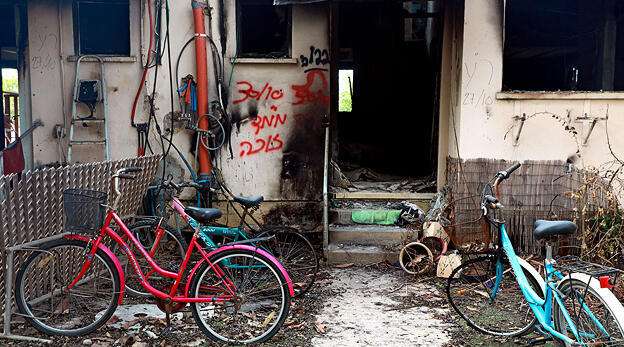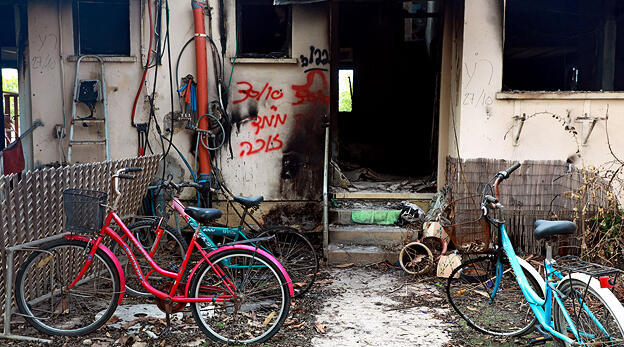
Reconstruction of 1,700 destroyed homes in Gaza periphery to cost NIS 2 billion
Of the thousands of houses damaged during Hamas’ 7/10 attack, the number of those designated for demolition varies; between 15-200 depending on who you ask. The cost of rebuilding the destroyed houses and infrastructure in Kibbutz Be’eri, alone is estimated to be at least NIS 300 million
The reconstruction process in the Gaza periphery has been accompanied by controversy over how much of it will be financed from the property tax compensation fund. According to the property tax criteria, only about fifteen of the damaged houses in the Gaza periphery are defined as a "total loss," requiring funding for their demolition and reconstruction. However, according to those involved in the damage assessment survey conducted by the Ministry of Defense, around 200 houses need to be demolished. This discrepancy reflects the gap between the needs of the residents of the region and the general criteria set by the tax authority. Responsible for bridging this gap will be the Tekuma (Revival) Administration, which has received a budget of NIS 18 billion ($4.8 billion).
Approximately 1,700 houses were damaged during 7/10, with 200 of them slated for demolition, according to information obtained by Calcalist,. The most severe damage occurred in Kibbutz Be’eri, Kfar Aza, and Nir Oz. Be’eri alone has around 125 houses designated for demolition. The estimated cost of rehabilitating the houses and infrastructure just in Be’eri is at least NIS 300 million ($81 million). This is also the case for Kfar Aza, where a tank and helicopter battle took place, and in Nir Oz, which was attacked by several hundred terrorists.
The severity and magnitude of destruction of these houses is unprecedented, mainly because much of the damage was caused by terrorists who were inside the homes.
Due to the property tax definitions, only a portion of the reconstruction budget will come from the property tax compensation fund. Estimates suggest that this portion will be between NIS 500 million ($135 million) - NIS 2 billion ($543 million). The property tax law defines a house as eligible for demolition based on engineering and financial conditions. If the floor and foundations are destroyed, the house can be demolished, but if the foundations are intact and only the walls are damaged, the house can be restored. Additionally, if the cost of renovation exceeds 60% of the house’s value then it can be demolished. In any other case, property tax will compensate only based on the renovation cost.
However, these conditions were not set with the magnitude of the damage of October 7th in mind. In many cases, even if the damage is repairable, residents are not willing to return, such as Kibbutz Be’eri. In one of the kibbutz neighborhoods, of the 44 houses, most of which were damaged, there are eleven houses which were only lightly damaged. Yet, the residents of the kibbutz are not willing to return to this neighborhood, where a massive battle took place on 7/10, and the horrible memories that it evokes. New houses for these families will be built in a different area of the kibbutz by Tekuma, which will also have to finance the construction of houses that are not included in the property tax criteria. Additional dilemmas arise when examining rows of houses sharing walls (railway houses). According to property tax regulations, compensation will be given only to the house that is damaged, not to the adjacent ones.
Overseeing the process is Tekuma Deputy Director Major General Yaakov Ayish, who met with representatives of the tax authority, including Amir Dahan, the director of the property tax compensation fund, and Miri Savion, deputy director of the tax authority. A comprehensive discussion is expected to take place soon.
The damage assessment survey in the Gaza periphery began in early November and is now in its final stages. The project was led by the Ministry of Defense under the leadership of Major General Roni Numa, reporting to the Tekuma Authority. The survey involved collaboration with various departments, including the engineering department of the Ministry of Defense, settlement and property tax divisions. Most engineering surveys were conducted by engineers from government housing company Amigor. Numa’s team will provide Tekuma with a summary report with detailed findings for each community. The findings will include not only damages to property but also overall impact, including roads, fences, and agricultural infrastructure.
New schools will be built far from the border
In the months since 7/10, ruined houses in the Gaza periphery communities were identified with graffiti-like signs on their walls. These signs were left by those involved in the damage assessment survey, a unique process due to the nature of the event. Orna Raviv, Deputy Head of the engineering and construction department in the Ministry of Defense, said: "Every team that entered a building marked it. In the first stage, Zaka entered every building; then, the Mine Clearing Authority entered to locate and clear any traps and remove ammunition or unexploded bombs left by the terrorists. In the next stage, a general survey was conducted in which buildings were categorized based on the extent of the damage. In the final stage, an in-depth engineering survey was conducted which provides the closest estimate of the costs to repair the houses."
According to Raviv, the surveys were coordinated with the local communities. "Before entering a location, we coordinated with a representative authorized by the community and requested permission to enter. In every meeting with residents, they described in detail what happened - unbelievable stories of heroism and tragedy," she added.
These surveys are a necessary first step in the process of rehabilitating the communities. The aim is to enable the return of residents to communities located 4 to 7 km from the border in February. Residents of communities within 4 km could return to their homes in August. In this group, there are communities that will take longer to return due to an extensive process of rehabilitation and construction.
The return of communities located more than 4 km from the border is possible due to a plan to build new educational institutions far from the border. For example, a regional school that was in Kibbutz Yad Mordechai will be relocated to Beit Hadar and Nitzan; the Sha'ar HaNegev High School will move to Bror Hayil and Ruchama.
To calculate the total costs of reconstruction, one must also add the cost of housing residents in hotels or with relatives. According to a Calcalist investigation, the evacuation of residents from the south and the north has thus far cost the country NIS 2.4 billion ($652 million). This includes NIS 1.6 billion ($435 million) paid by the Ministry of Tourism to hotels and NIS 800 million ($218 million) paid by the National Insurance Institute as self-evacuation grants to residents who chose to stay with relatives or friends. This payment is calculated at NIS 200 ($54) per adult per day and NIS 100 ($27) per child per day. The National Insurance Institute payments cover 111,000 individuals, including 45,000 residents of Ashkelon with no bomb shelters.















